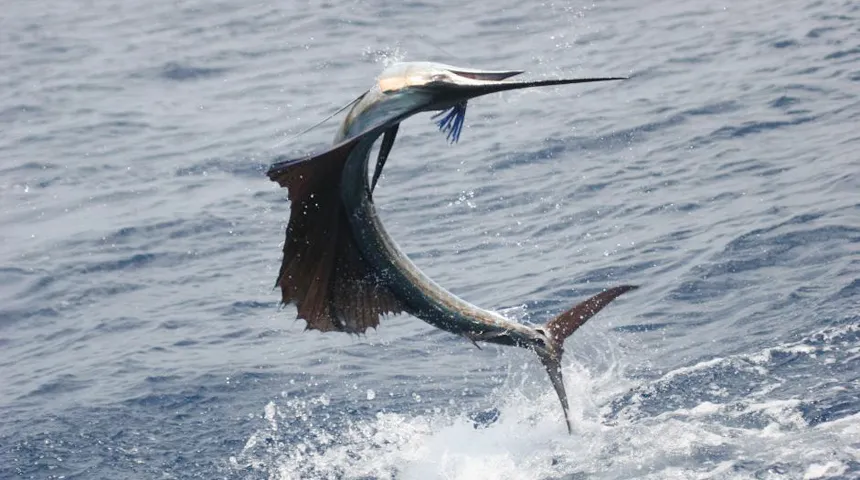Secrets of a sailfish attack
The large, long-nosed fish use their rostrums more like a sword than a spear

Sailfish are named for the sail-like fin on their backs, but they can also be characterized by their elongated bills.
John Graves/NOAA
- More than 2 years ago
Many of us are familiar with sailfish — relatives of marlin— only from seeing them on the walls of sport fishermen. But watching them underwater, whether in person or on video, shows how beautiful the animals are in their natural habitat (see video below).
These fish hunt in groups, driving schools of smaller fish, such as sardines, toward the surface. Then each sailfish takes a stab at the prey. Just what’s going on can be hard to see, so Paolo Domenici of the Istituto per l’Ambiente Marino Costiero in Torregrande, Italy, and colleagues slowed down the action.
The researchers located sailfish off the coast of Cancun, Mexico, in February 2012 by following frigate birds, pelicans and other birds flying above sardine schools. Then they created high-speed videos of the sailfish as they hunted the sardines. The videos gave the researchers a detailed look at what was going on underwater. Their study was published April 22 in the Proceedings of the Royal Society B.
Sailfish are fast swimmers, but they’re not relying on speed to catch their meals, the researchers found. Instead, a sailfish stealthily inserts its long nose (also called its rostrum or bill) into the school. The sardines don’t take notice, and they’re unprepared for what happens next: The sailfish either makes a slashing motion with its rostrum, injuring several sardines, or it taps a single sardine, destabilizing it. The sailfish’s rostrum may look like a pointy spear, but the fish never actually uses their weapon in that way.
The sardines are unable to do anything in response to the sailfish’s attack. And though sardines are fast swimmers, they can’t swim fast enough to avoid the tip of the sailfish’s rostrum, which has “one of the highest accelerations ever recorded in an aquatic vertebrate,” the researchers note.
“Based solely on speed, large fish are expected to eventually catch small fish, but when maneuverability and acceleration are taken into account, large fish are often at a disadvantage,” the researchers write. “Therefore, the use of morphological adaptations that can be maneuvered effectively, such as the sailfish bill, can be critical for overcoming these challenges thereby allowing large predators to catch their evasive smaller prey.”
Most sailfish attacks didn’t result in dead sardines. Only 10 percent of slashes and 33 percent of taps resulted in a direct capture of a sardine. And slashing never resulted in immediate death. But as different sailfish attack a school, more and more sardines are hurt. This type of hunting is surprising because it’s more typical of animals that hunt in packs, such as wolves. Sailfish hunt in groups, but those groups regularly break up and reform with new members.
The underwater videos also picked up some interesting details in the behavior of a sailfish during an attack: The fish keeps its large dorsal fin and pelvic fins erect, probably to keep its body stable. And its body changes color, with the normally bluish-silver lateral sides darkening to almost black just before beginning an attack. Some of the sailfish also showed vertical stripes and blue and orange spots on their sides when they were attacking a school of sardines.
It’s not quite clear what the color changes mean, but they could be some kind of communication between sailfish. The fish attack a school only one at a time — possibly to avoid getting slashed by a compatriot — and they may be using the changes in body color as a way to signal who goes first.





